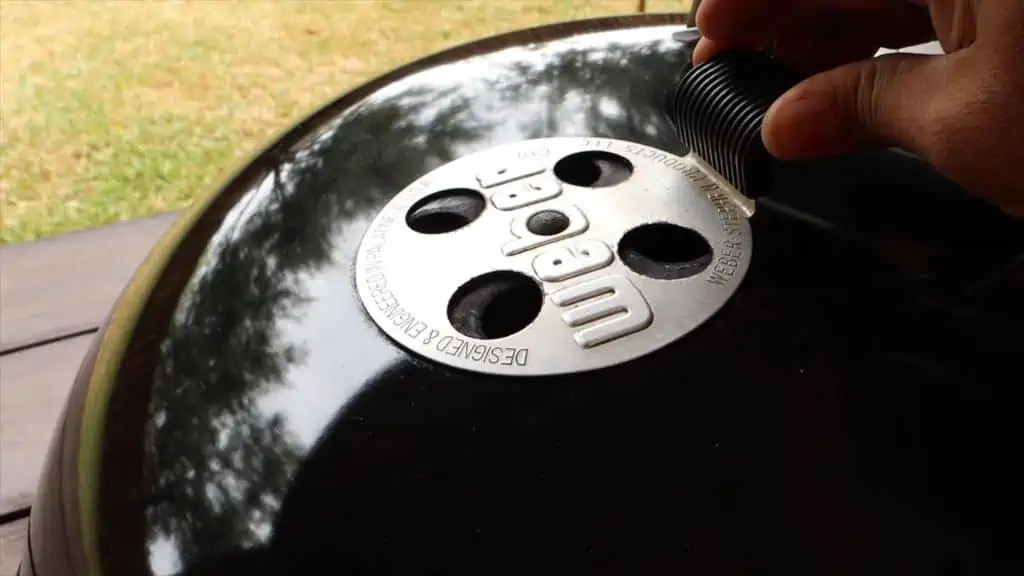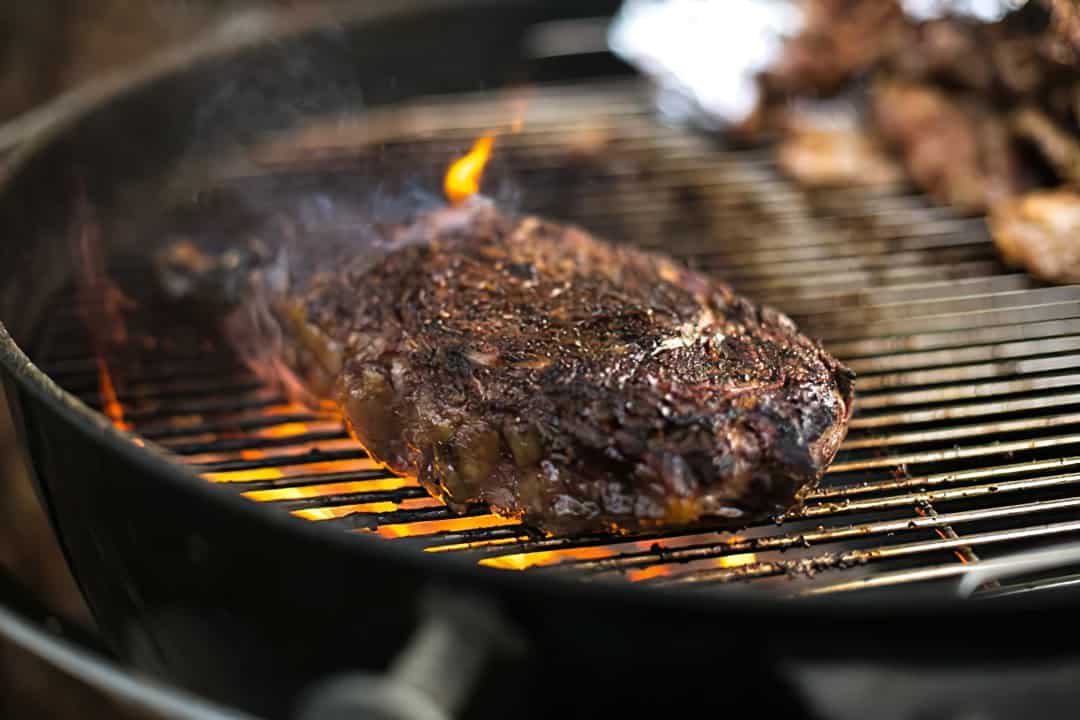The most important skill you must acquire to master charcoal grill cooking is undoubtedly the skill on how to control temperature on charcoal grill. To properly and consistently manage the temperature of your grill or smoker for optimal food flavor, it takes talent, expertise, and constant practice.
It can be difficult with charcoal grill because you’re working with live coals or wood that may come in a variety of shapes and sizes and burn at various rates and temperatures.
However, you can only produce consistent results and get rid of overcooked or undercooked food by managing the temperature of your charcoal grill or smoker. Configuring your grill and managing it with the vents and dampers will be simpler if you understand the fundamental physics of how fire, heat, and air work.
4 Ways on How to Control Temperature on Charcoal Grill
In contrast to gas grills, charcoal grills need some finesse to regulate the temperature. But if you pick up the correct abilities, with a little bit of effort, you can master the art of temperature regulation and begin wowing your loved ones with your primitive prowess.
Effective temperature control basically only involves four approaches. If you can manage them, you will be well on your way to mastering the art of grilling. You will probably wind up relying mostly on one or two of these techniques depending on how you utilize your grill. It’s still essential to be conscious of all your possibilities.

1. CREATE A TWO ZONE FIRE
You can take control of how well cooked your meat it by simply moving it to the proper side of the cooking grate. This is done by dividing the cooking surface into hit zones for searing and cooler zones for indirect cooking.
There is a workaround if your grill does not have this useful feature. To start a fire with two or more zones, use the first procedure. Then, as needed, you can shift your food between the hot and cool areas of the grill.
To construct a two-zone fire:
- Arrange all of your coals to one side of the coal grate.
- Dot them equally over half to two-thirds of the space.
- Put a new cooking grate in place.
- You can now grill or cook directly over the coals, and indirectly cooking is done in the space that is farther from the fire.
Move the food across to the side of the grate without coals if you want to cease grilling it or cook it indirectly. Warm air will circulate around the food that is sitting in the indirect cooking zone to cook it by convection. The meal will be cooked evenly as a result, not just on the top but also the inside.

2. INCREASE OR DECREASE AIRFLOW BY ADJUSTINGYOUR GRILL VENTS
More airflow results in a hotter grill when using charcoal to cook. In contrast, opening the lid on a gas grill will only allow heat to escape. When turning on your grill, it’s crucial to keep all of the vents fully open. They require a lot of air to get the coals blazing.
The fire grows hotter the more air that rushes in. Simply limit the airflow in order to raise the temperature. The dampers or bottom vents allow air to enter. The top vent, also known as the exhaust vent or smokestack, is where heat, smoke, and burnt gases escape as heat rises. More air is then drawn in from the bottom, farther oxygenating the flames.
You can carefully manage the pace of burn, and as a result, the temperature in your grill or smoker by adjusting the airflow through your vents.
- Start with your top vents half open and your bottom intake vents wide open.
- Close your bottom vent to about half once the fire has subsided.
- Monitor the temperature of your grill as it rises toward your target using a trustworthy pit probe (not the one that comes with the grill!). It is advised to use a reliable wireless meat thermometer for the task.
- Open the bottom vent slightly to raise the temperature if it doesn’t reach the desired levels. Close the bottom vent a little bit if the temperature exceeds your goal level. Ten minutes later, assess the development. (Any modifications require at least 10 minutes to become effective.)
- It can be difficult to balance if you focus on using only the bottom vent for control. The vent at the bottom or intake will have the biggest impact. Additionally, keep in mind that the top vent needs to be open in order to pull air from the bottom and release the burned gases. By closing the vent, you smother the flames and eliminate one leg of your fire triangle.
- You can experiment until you locate the ideal location for your vent openings. To save time later, mark down the damper settings that work best in a permanent marker.
- Of course, you may purchase temperature controllers that can measure and automatically manage the amount of air entering the grill in order to precisely and fully hands-free set your desired temperature.
- It eliminates the fun and uncertainty of maintaining a constant temperature. But you still need to be able to manually manage them.
3. MAKE SURE THE MEAT IS NOT TOO CLOSE TO THE HEAT
One final thing to think about is how close your meat is to the fire once the temperature inside the grill or smoker has stabilized. Your food will cook more quickly and at a higher temperature the closer it is to the coals. This is not a concern with an offset cooker because the fire is not close to the meat. This can, however, be a problem with tiny barbecues and smokers. Even though the inside air temperature is a perfect 225 degrees Fahrenheit (107 degrees Celsius), if your meat is placed too close to the fire, it will immediately overcook on that side.
Keep in mind the distance between the meat and the heat source. To prevent scorching, turn the meat every 15 to 20 minutes.
Using a heat shield is an additional strategy. Some of the top charcoal grills have them as standard equipment. If yours doesn’t, don’t worry; there is an inexpensive and simple fix.
Put a second layer of foil under the meat and on the side that will be closest to the embers. This aids in deflecting direct radiant heat away, allowing your food to cook only under convective heat, which corresponds to the air’s actual temperature. Cooking grates that can be adjusted come with some grills, which is convenient. If you think the food is getting too warm, simply move it farther away, and vice versa.
4. PUT ON A GRILL SHIELD
You may quickly create a shield out of aluminum foil to block the heat if food is cooking more quickly than you anticipated and you need to take action.
- Just get some foil
- Fold it twice or three times.
- Put it underneath the food item that is going to burn.
By reducing the amount of radiant heat that is hitting your food, you can somewhat delay the cooking process with this technique, albeit it won’t stop the food from cooking entirely.
When grilling at high temperatures, the four strategies mentioned above will be quite effective.
Troubleshooting the Heat on Your Grill
It might be difficult to regulate the temperature, particularly with cheaper grills and smokers. Usually, they “leak” extra air from the seams, the area surrounding the doors, or screw holes. By adding gasket seals to the door or cover and plugging any gaps or holes with a high heat sealer, you can lessen leakage.
Simply consider these as a permanent vent opening and modify the other vents as necessary if you don’t want to bother sealing everything tightly. The grill may not be getting enough air if you’re having trouble reaching the proper temperature. That usually refers to ash accumulation at the bottom vent.
Before lighting a new fire, always empty the ashes. Make sure the coals are supported on a grate above the vents rather than directly on them. If the grate burns through, replace it. Additionally, confirm that your thermometers are calibrated correctly and reporting the correct temperatures. Nothing is more frustrating than trying your best but failing because your thermometer doesn’t read correctly.
There is still something to check. If the grill or smokestacks are tipped sideways for storage or if you don’t grill frequently, mice and birds may build nests there. Hey, I wouldn’t mention it if it didn’t happen. You might want to spend money on an insulating blanket or construct a windbreak around your grill if you’re cooking outside in windy or cold weather. Due to their poor insulation and thin walls, particularly more affordable grills and smokers lose a lot of heat. Additionally, cold, wet, and windy weather can make it very difficult to reach and maintain temperatures.
Conclusion
You can do more than just sear beef steaks and flip burgers while using a charcoal grill. In actuality, a grill may be used to prepare a wide variety of foods. Being able to regulate the temperature of your grill is the key. The possibilities for what you can cook on your grill are virtually endless once you get a few techniques down and understand the basics of temperature control.
Hi, I’m Adam and I’m a HUGE fan of Food and Cooking.
Do you enjoy grilling sessions with your family while staring at the beautiful fire pit flames?
Flame Gorilla is the site to learn how to have that perfect backyard experience.

